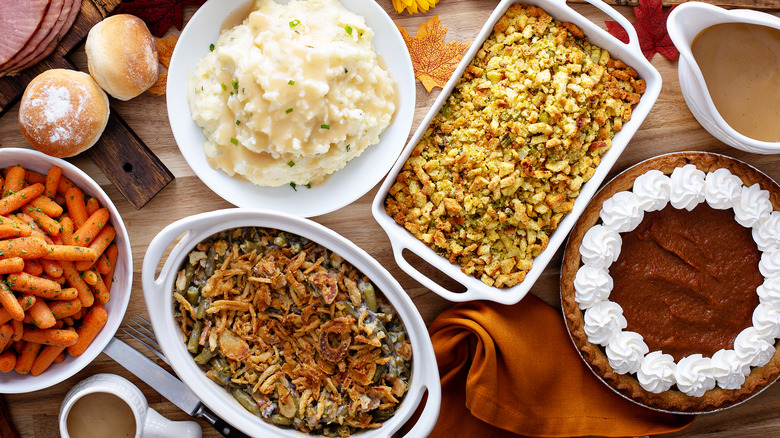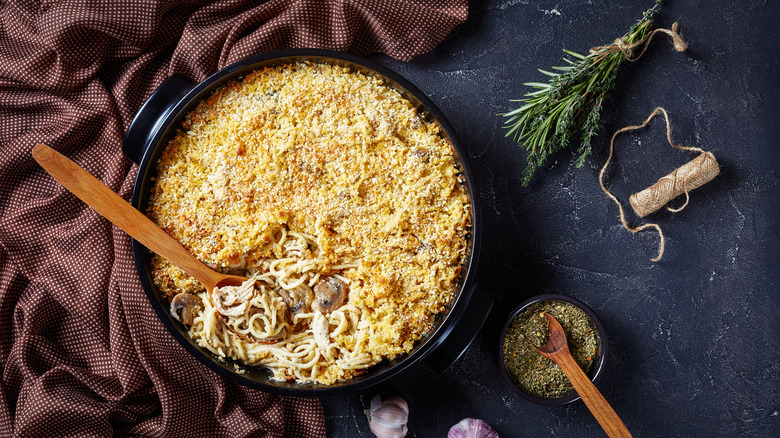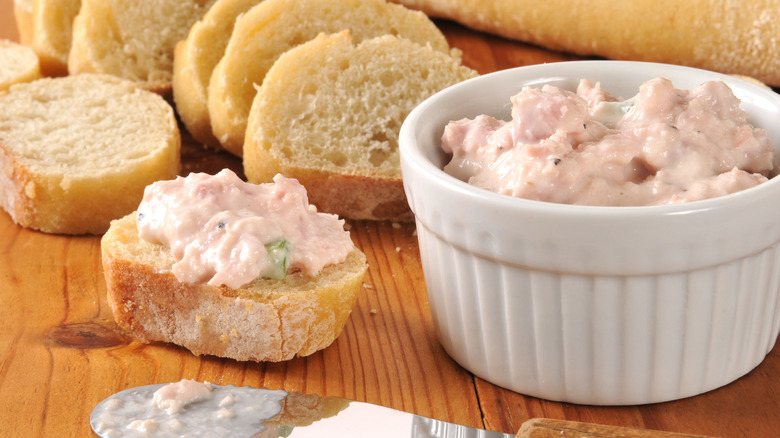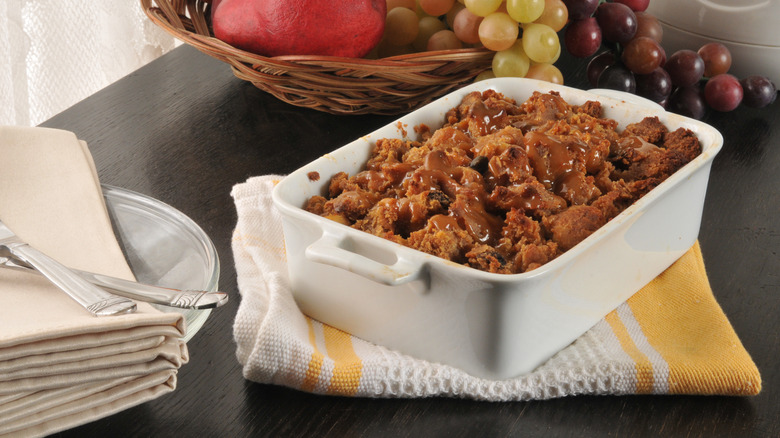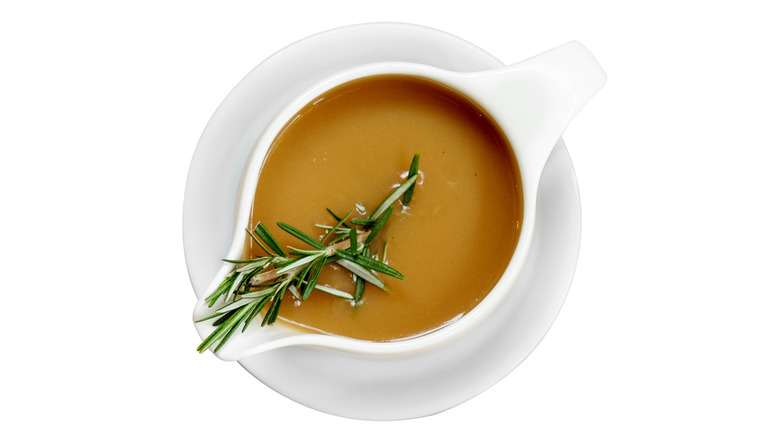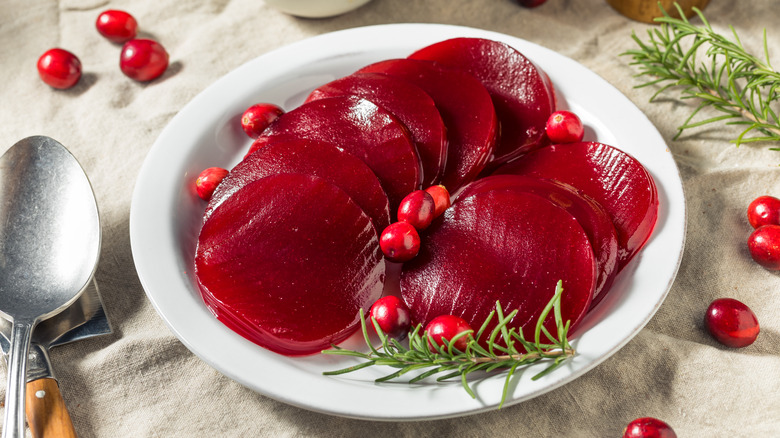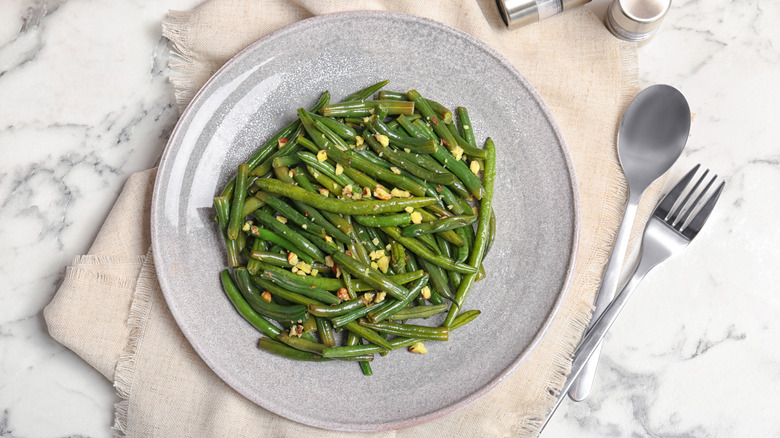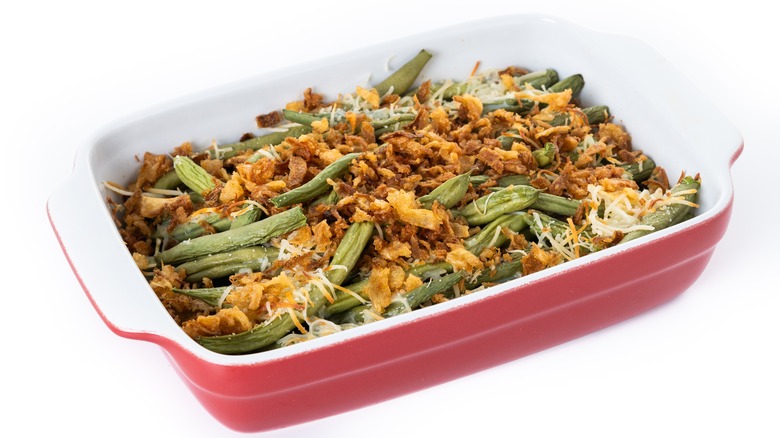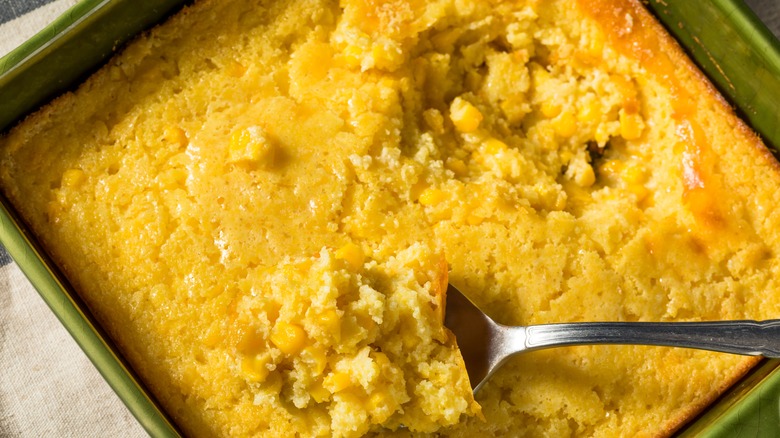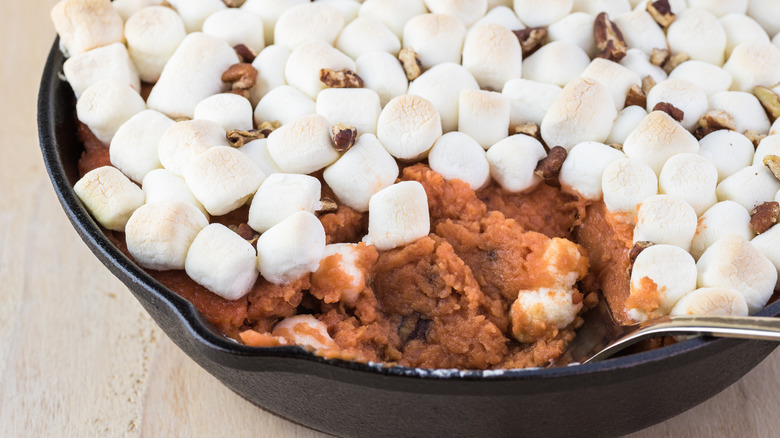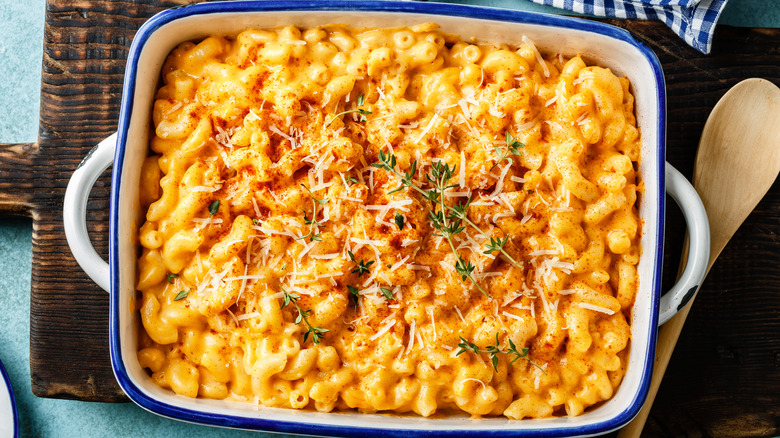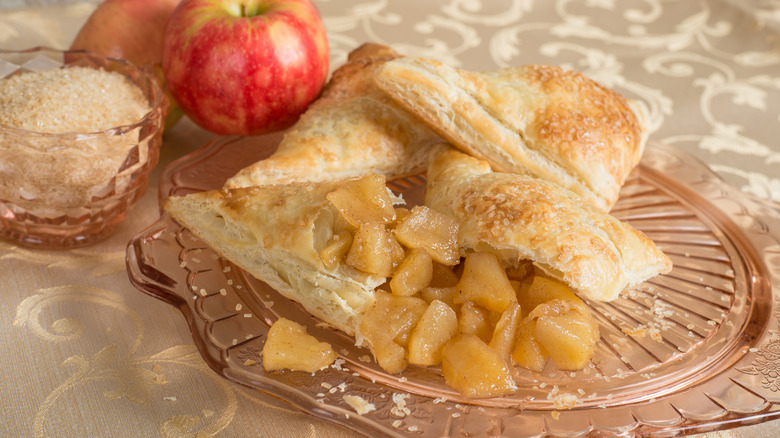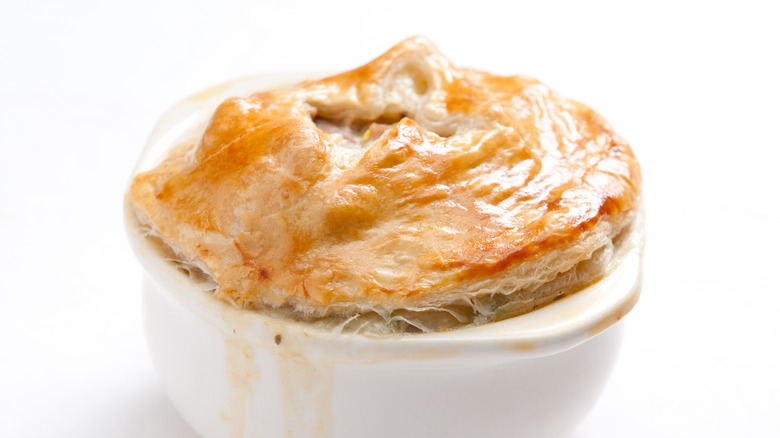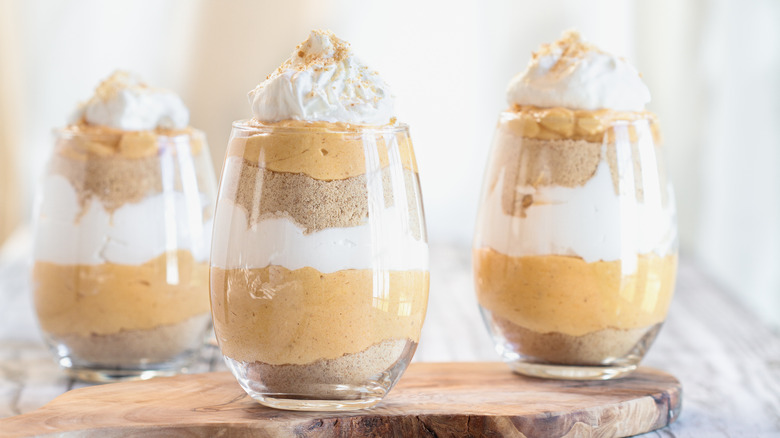13 Pro Tips For Crafting A Thanksgiving Feast From Canned Foods
Thanksgiving is just around the corner, and most of us have begun the exciting yet arduous menu planning process for the big event. We know the staple dishes everyone expects to see around the dinner table. Many of these take time and effort to prepare from scratch. Furthermore, these dishes can become quite pricey, rendering them unattainable for those on tight budgets. But there's a little trick I like to keep in my back pocket and want to share with you: canned foods.
Having prepared many Thanksgiving dinners in my restaurant and for friends and family, I have had plenty of experience figuring out sensible ways to take shortcuts that will not compromise any flavor or nostalgia that makes this holiday special. These include utilizing canned foods. Some of these may seem inauthentic or lacking in elegance, but they don't have to be. All it takes is creativity to incorporate budget-friendly canned foods into your menu.
The pros to using canned foods are affordability, convenience, and the opportunity to spend less time in the kitchen and more time enjoying the company of your guests. These are reasons enough to use them. Additionally, many of these dishes will transport us back to childhood, when using canned foods in recipes was commonplace and expected. Here are my favorite tips for crafting a Thanksgiving feast using canned foods.
1. Canned turkey
Let us start at the very beginning with the turkey. Certainly, canned turkey is not identical to a succulent whole roast turkey. But it does have its advantages. A whole turkey can be a pain to cook, is messy, and takes too much time to prepare. It also yields both light and dark meat. If you have a family that prefers predominantly breast meat, like mine, you can opt for canned turkey made only from that.
Most canned turkey is pretty straightforward. Pre-cooked turkey is preserved in salt and ready to eat straight from the can. You do not have to fuss with ensuring your turkey has reached a safe temperature to eat, and you can pop the turkey straight from the can into whatever recipe you want to use it in. And it's almost guaranteed to be moist and delicious.
Canned turkey works best in simple casseroles where it can be the star or in soups and stews. For Thanksgiving, combine canned turkey with a creamed soup, vegetables, and cooked pasta for something akin to a tetrazzini recipe. It can also be used as a base for dressing. According to the CDC, it is unsafe to stuff a turkey due to the possibility of undercooking the stuffing, but who says you cannot stuff turkey into your dressing? It's a perfect one-dish meal the whole family will love.
2. Canned ham
Before we dive into a discussion about canned ham, we are not talking about Spam. There is nothing wrong with Spam, but for Thanksgiving, what you are looking for is boneless, cured ham that has been formed to fit into a can. It is cost-effective, easy to use, and is as tasty as a spiral-cut ham when prepared well.
Canned ham is the perfect alternative for those who do not particularly care for turkey. Although you can use it straight out of the can, some prefer to rinse it before using it to eliminate some of its salinity. This is a good practice, but dry it thoroughly with paper towels to eliminate excess moisture, or it will water down your dish and not brown well.
Ham salad is a class Midwestern appetizer recipe and would be great to serve for Thanksgiving. Just cut up the ham, mix it with relish and mayonnaise, and you are ready to smear it on crackers. You can also glaze a whole canned ham and then serve it sliced for a more elegant presentation tableside. We recommend a glaze with a fruity base.
And, like canned turkey, ham is a perfect base for a casserole. Add a creamed soup, starch, and perhaps a canned fruit, like pineapple, for a sweet and savory delight.
3. Canned bread
If you have never heard of canned bread, you are likely not alone. It is a New England classic that was invented in 1928 by baked bean manufacturers B&M. This bread, which has been described as a cross between rye bread mixed with zucchini bread, is slightly dense but flavorful. It comes in two varieties, plain and with raisins. Historically, this bread would be served as a base for baked beans, but it is infinitely more versatile than that.
For appetizers, you might want to slice and toast canned bread as a base for canapés, including that ham salad you made. As far as your side or main dishes are concerned, you could easily use it as the base for a dressing. Cut the bread into cubes and toast them before adding the rest of your ingredients, such as your canned turkey or ham and cream soup.
Where this ingredient can shine is in the dessert department. Cubed and toasted portions of the plain or raisin variety could be showcased in a sweet version of a classic panzanella or as the base for a bread pudding with dried fruits and nuts. The distinct texture of canned bread makes it ideal for sopping up liquid, giving your bread pudding a marvelous supple texture.
4. Canned gravy
Canned gravy can be a lifesaver for a Thanksgiving dinner. It is quick and easy. But it can also be a bit boring and quite salty, depending on the brand. The key is to know how to augment it to have a more complex flavor and cut some of that salinity. Some of our favorite ways to doctor up canned gravy include adding a hint of heavy cream or milk and a touch of wine, cognac, or brandy before reheating it. You can add some zing with Dijon mustard or balsamic vinegar.
And while you may want to incorporate some umami savoriness, be careful not to overdo it. Some umami-rich ingredients, like Worcestershire and soy, and hot sauces, such as gochujang, are also quite salty. Moderation is key.
Gravy is a stellar way to moisten your turkey or ham. It can also be a great way to add richness to recipes. Try incorporating it into your casserole instead of, or in addition to, canned cream soup. It is also a great way to add thickness to a stew without making a roux from scratch. And if you have some frozen fries, top them with cheese curds, chopped canned ham, or turkey, and you've got a quick version of a Thanksgiving poutine you could serve as an appetizer.
5. Canned cranberry sauce
Canned cranberry sauce remains a staple on Thanksgiving tables even though many of us have attempted to produce fancy homemade recipes for the side dish.
The first jellied cranberry sauce was introduced in 1912 by the Ocean Spray Preserving Company. It was initially intended to help use up imperfect berries and to extend their life cycle beyond the Autumn season. While most of us open the can and plop it onto a serving plate, there are a few ways you can elevate this Thanksgiving classic. Garnishing it with dried fruits and nuts is always a nice touch. You can also pre-slice the jelly and season it with cinnamon, vanilla, and a hint of orange zest.
Don't stop there. Cranberry sauce can be a brilliant and colorful, sweet and tangy addition to both savory and dessert recipes. Try adding it to your dressing for a surprising pop of flavor. You can also incorporate some into any casserole along with your canned meat and gravy. And for desserts, try adding some to that bread pudding you made with canned bread. It'll melt into the pudding, getting soaked up by the bread and giving it a marvelous gooey texture.
6. Canned green beans
When shopping for canned green beans, you will likely come across two kinds — regular and French-style. The primary difference is that French-style green beans, or haricots verts, are usually thinner and more tender. That said, to use these in recipes like green beans almondine or the classic casserole, either variety will do. Once canned, you won't be able to detect an appreciable difference.
The most popular way to eat these canned vegetables is in the legendary green bean casserole. Try doctoring this classic by incorporating umami-rich ingredients like Worcestershire or soy sauces. You could also try using a different creamed soup besides the classic mushroom. Great options would include a cream of cauliflower, a cream of celery, or a cream of chicken. Lastly, add chunks of chopped canned ham or turkey to the recipe. This will turn your casserole into a one-dish meal.
And don't limit yourself to just the classic casserole. Canned green beans can be used in many other ways, from soups and stews to salads. And for a quick appetizer, try wrapping them in bacon and brushing the top with a sweet and sour glaze before baking them to crispy perfection.
7. Canned cream of mushroom soup
It would be hard to imagine a Thanksgiving without the legendary green bean casserole. The recipe for this dish dates back to 1955 when a member of Campbell's Home Economics department came up with an idea for what was known as "Green Bean Bake," as stated on Campbell's Soup Company. The recipe was intended to be served year-round. It wasn't until 1960, when Campbell's began printing it on labels of its cans of cream of mushroom soup, that it became a Thanksgiving staple.
But cream of mushroom soup is far more versatile than this humble casserole. It can certainly be used for many other casseroles, including ones featuring your canned ham or turkey. It can also be added to dressings, like one made with canned bread, as well as potato and pasta dishes.
One tip to remember when purchasing canned cream of mushroom soup is that you can obtain it in low-sodium iterations. It is highly recommended that you opt for these whenever possible, particularly if you intend to augment recipes with umami-rich ingredients like Worcestershire or soy sauces, which are also quite salty.
8. Canned creamed corn
Creamed corn is a simple and easy side dish to serve as is. Just open the can, reheat the contents, and serve. That said, you may want to doctor this up with some added color and flavor. Frozen peas or peppers work great, as would some finely chopped canned ham or turkey. You might also consider adding a hint of heat with sriracha or gochujang for a savory change of pace.
Creamed corn can also serve as the base for numerous recipes. First and foremost, it is an ideal base for savory corn pudding. It can also be added to your canned bread dressing for a hint of color and texture. And if you want to be snazzy, add it to a casserole with canned turkey or ham, cranberry sauce, canned sweet potatoes, and a hint of cheese.
Lastly, consider using canned creamed corn in a dessert. It can be whipped into a custard, pudding, or even ice cream. You could also add it to cookies, fruit crisps, and to augment a cheesecake. In keeping with our canned theme, if you plan to use canned bread for a bread pudding, add some of your creamed corn with the cranberry sauce for the ultimate mash-up.
9. Canned sweet potatoes
If you have ever purchased canned sweet potatoes, you may wonder why you often see them labeled as yams. They are not the same thing, and this double labeling is confusing. Yams and sweet potatoes may look similar on the outside, but they are two different species of tuber. They also taste very different, with yams being far less sweet and more starchy than sweet potatoes. Yams are not particularly popular in the U.S. Canned yams made from sweet potatoes are legally required by the USDA to be labeled with both names, hence the confusion.
For our purposes, what you are seeking are sweet potatoes. They make for a quick ingredient in myriad recipes. They can be used in soups, stews, and the classic marshmallow-donned casserole. They can also be combined with your canned ham or turkey and cream of mushroom soup for a delectable casserole-like bake.
And whatever you do, don't skip using them in desserts. They can be turned into a pie using a store-bought crust but are also great in soufflés, custards, cheesecakes, puddings, and even ice cream. Treat them the same way you would canned pumpkin in terms of seasonings, using plenty of cinnamon, cloves, nutmeg, and allspice to capture those classic Autumnal flavors.
10. Canned macaroni and cheese
You may have eaten macaroni and cheese from a box, but did you know you can get it in a can? It is a real thing, and it is pretty awesome. It is easy to reheat in a saucepan, the pasta isn't mushy, the sauce is creamy, and it doesn't taste like fake cheese. Since macaroni and cheese is a staple at some Thanksgiving tables, this is a perfect alternative to boxed variations or making it from scratch, which I can attest is often not as popular, especially with children.
To doctor this up, I recommend adding some color with frozen vegetables, like peas or spinach. You can also toss in some chopped-up canned turkey or ham. Alternatively, turn this into baked macaroni and cheese. Instead of using bread crumbs as a topping, try toasting chunks of canned bread to put on top. And add some canned sweet potato, creamed corn, and green beans for the ultimate Thanksgiving canned food mashup.
11. Canned apple pie filling
Thanksgiving would not be the same without dessert, but baking isn't everyone's cup of tea. It is labor intensive and requires precise measuring, which for some of us is a challenge and a bore. Though you can purchase pre-made pies or desserts, they are seldom as good as homemade.
If you still want to do something special that isn't as complicated, consider getting some canned apple pie filling. It comes pre-seasoned with cinnamon and other flavorings, is sweetened, and is already thickened, so you don't have to fuss with peeling apples, trying to keep them from browning, having to chop them up, and having to cook them.
You could pop this filling into a store-bought pie crust, but there are other options for a festive dessert. One I am super fond of is combining it with canned bread to make a bread pudding. Another option I like is layering it onto canned crescent rolls and baking these to create the perfect little apple turnovers. Lastly, you can make a basic crumble using granola mixed with brown sugar and butter as a streusel topping. All you will need to finish off the dessert is a scoop of vanilla ice cream, and all of your guests will be impressed.
12. Canned crescent rolls
Speaking of not baking, let's talk about canned crescent rolls. They are one of the greatest hacks in the kitchen because they are easy to use and versatile. Crescent rolls can star in virtually every part of your Thanksgiving meal, from appetizers to desserts. For a quick and easy appetizer, layer chopped canned ham or turkey with cheese inside the pastry before rolling it up and baking. You can also make a sweet and savory iteration by combining the ham or turkey with canned cranberry sauce before rolling the pastry and baking it.
For the main course, you can always use the crescent rolls as a delightful topping for a turkey or ham pot pie made from cream of mushroom soup, canned green beans, and canned creamed corn. And whatever you do, don't forget the dessert. Canned crescent rolls can easily be repurposed as a makeshift pastry crust for pies, turnovers, bars, and dumplings using either apple pie filling, canned sweet potatoes, or cranberry sauce.
13. Canned custard
If you have never heard of canned custard, you will want to check it out. Unlike homemade custard, this does not contain any eggs. It is a combination of sugar, milk, oil, and flavorings. This yields a rich, luxurious sauce that can be used as a delicious topping for virtually any dessert. It would be a great alternative to ice cream atop your quick apple turnovers or your canned bread pudding recipe.
Canned custard is commonly used for making trifle recipes. If you want to create elegant individual desserts that delight your Thanksgiving dinner guests, try layering slices of canned bread, preferably the raisin flavor, with canned custard, apple pie filling, and a hint of cranberry sauce. Top this with another layer of the canned bread and a touch more custard, and place these in the refrigerator. As the ingredients rest in the refrigerator for a few hours, they will bind together, and the canned bread slices will absorb all those luscious liquids.
